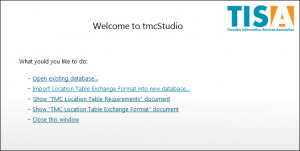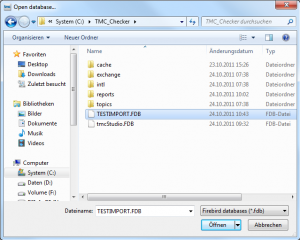Difference between revisions of "Checker"
| Line 35: | Line 35: | ||
<br> | <br> | ||
[[File:DifferentErrors.png|frameless|450px]] | [[File:DifferentErrors.png|frameless|450px]] | ||
| + | <br> | ||
| + | {{Warning}} | ||
| + | <br> | ||
| + | If the Check has to be redone, not all the data has to imported for a second time. When using it for again, at the Welcome-window '''Open existing database...''' is chosen for importing the data of the prior use. | ||
| + | <br>[[File:OpenExistingDatabase.png|frameless]] | ||
| + | <br> | ||
| + | The file saved before is chosen and afterwards opened. | ||
| + | <br>[[File:Testimport.png|frameless]] | ||
| + | <br> | ||
Revision as of 09:51, 24 October 2011
How to make a TMC Check
To make a TMC Check, when opening the file, Import Location Table Exchange Format into new database... has to be chosen.

Afterwards a window appears, where in Database file the appropriate file is chosen.

As Source directory the folder Exchange files in Directory is chosen.

And lastly, the function Run semantic checks has to be activated.
![]()
Now the wanted data are imported, created and checked. This step may take some seconds.

When finished, due to the activation of the semantic check the codes with errors are shown.
To see them directly, Show Only Checks Containing Errors can be clicked.
![]()
The errors found in the Structural Checks, are visible when opening Checks\Structural Checks. Again, they are directly shown when activating the filter.

For exporting the information, the most suitable way is to do it by a Combined Report.

The file is saved as an Excel workbooks (*.xls) in the appropriate folder.

When clicking save, the excel file will automatically be opened. It show the different errors found while checking the TMC.

![]()
![]() Important Advice
Important Advice
If the Check has to be redone, not all the data has to imported for a second time. When using it for again, at the Welcome-window Open existing database... is chosen for importing the data of the prior use.

The file saved before is chosen and afterwards opened.
